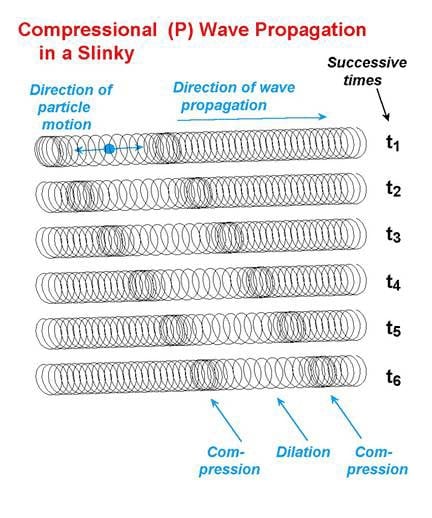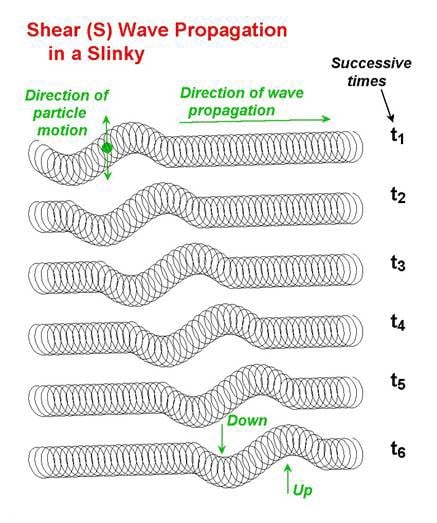You can imitate the motion of P and S waves using a Slinky® (the metal ones work best). The S wave can also be simulated using a piece of rope in place of a Slinky®. These activities work best with a partner and on a flat surface such as a table or the floor.
Making P Waves
P waves consist of a compressional (shortening) motion and a dilational (expanding) motion that both lie along a line. As you make your own P wave in this exercise, try to identify the compressions and dilations in the Slinky®. Here's how you do it:
- Place the Slinky® on a flat surface. Have your partner hold the opposite end of the Slinky®. If you don't have a partner, you can tie the Slinky® onto a hook in the wall or onto a door knob (close the door first) and try this activity in the air.
- Holding the other end of the Slinky®, walk away from your partner, or from the wall or door.
- Stop walking away when the Slinky® isn't sagging anymore (if in the air) or there is no more slack. Don't pull the Slinky® too tight; just take up the slack.
- Push your end of the Slinky® towards your partner in one, quick motion (if the Slinky® is suspended in the air, quickly jerk your end of the Slinky® towards the wall and then back). Don't let go of the Slinky®.
You'll see waves similar to P waves moving back and forth along the Slinky® like in the picture below:

Making S Waves
When making your S wave, notice how the Slinky® itself moves in a direction perpendicular to the direction that the energy is traveling in (perpendicular to the direction of wave propagation). S waves are more complex than P waves, but they should be easier to simulate in this activity:
- Place the Slinky® on a flat surface, and have your partner hold the opposite end of the Slinky®. If working alone, tie one end of the Slinky® to a hook on the wall or a door knob (close the door first).
- Holding the other end of the Slinky®, walk away from your partner, or from the wall or door.
- Stop walking when the Slinky® has only some slack left. If working alone and the Slinky® is suspended in the air, you want to stop walking only when the Slinky® no longer sags in the air. Don't pull the Slinky® tight; just take up most of the slack.
- Quickly jerk your end of the Slinky® from side to side once. If the Slinky® is suspended in the air, a quick jerk up and down once is sufficient. Don't let go of the Slinky®.
You'll see waves similar to S waves moving along the Slinky® like in the picture below:
